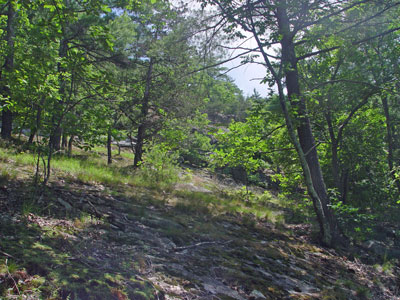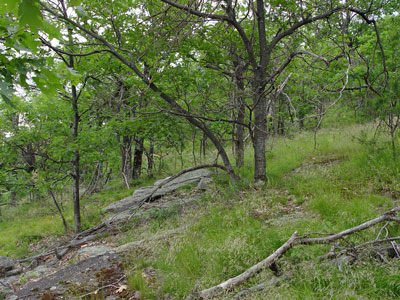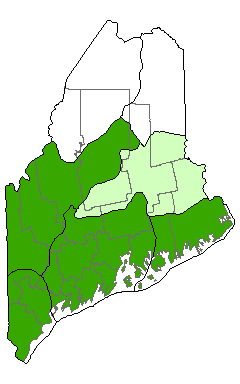DACF Home → Bureaus & Programs → Maine Natural Areas Program → Communities, Plants, and Animals → Natural Community Fact Sheets→ Oak - Pine Woodland
Printer Friendly Fact Sheet - 800 KB pdf (Get a free copy of Adobe Acrobat Reader)
Oak - Pine Woodland
Scientific Name: Oak - Pine Woodland; State Rank: S4

- Community Description
- Soil and Site Characteristics
- Diagnostics
- Similar Types
- Conservation, Wildlife and Management Considerations
- Distribution
- Characteristic Plants
- Associated Rare Plants
- Associated Rare Animals
- Examples on Conservation Lands You Can Visit
Community Description: These woodlands support a partial canopy (20-70%) dominated by red oak, or red oak with white pine or red spruce (rarely with red pine). The trees are widely spaced and often stunted, with an open understory. Gray birch is a common small tree. The herb layer is well developed (>25% cover), with one-third to nearly all of the layer consisting of dwarf shrubs. Lowbush blueberry is the most abundant dwarf shrub; sheep laurel is also common. Herbs form 1-20% cover among the dwarf shrubs. The bryoid layer is patchy, sparse, and variable in composition. While this is categorized as a “mixed” type, individual examples may be either mixed (>25% conifer and >25% deciduous) or deciduous (<25% conifer); they are otherwise very similar. Back to top.
Soil and Site Characteristics: Sites occupy upper hillsides and low ridgelines, with slopes up to 30% and elevations up to 1500’. South aspect is more likely than north. The substrate is typically thin sandy to loamy soil (<25 cm) over bedrock or coarse till, occasionally with a layer of poorly decomposed duff over the mineral horizons. Soils are acidic (pH 5.0-5.2). Many sites were former pasture and/or have evidence of past fire. Back to top.

Diagnostics: Canopy closure is less than 65% and red oak is dominant. Trees are short and spreading, or pines are dominant with lesser amounts of red oak, beech, sugar maple, or ash. The herb layer exceeds 20%, with lowbush blueberry, sheep laurel, or sweetfern prominent; graminoids are often abundant. Back to top.
Similar Types: Oak - Pine Forests are similar and may be contiguous with this type. They are distinguished by their higher canopy cover (>75%), taller and straighter trees, and more sparse herb layer (generally <30%) with little cover of heath shrubs. Back to top.
Conservation, Wildlife and Management Considerations: This community appears to be relatively stable in Maine, with little habitat conversion. Fire has apparently played a role at some sites by preventing the invasion of fire sensitive hardwood trees and shrubs. Many sites receive recreational use. In a few locations that use is heavy enough to have degraded the community, but most recreational foot traffic is compatible. Communications or wind power towers have degraded some sites on mid-elevation summits.
This community type hosts several rare Lepidopteran species that feed on oaks, including red-winged sallow, barrens chaetaglaea, barrens xylotype, similar underwing, and oblique zale. Back to top.
Distribution: Eastern Broadleaf Forest Province and southern portions of the New England - Adirondack Province and Laurentian Mixed Forest Province, extending southward and westward from Maine. Landscape Pattern: Small Patch. Back to top.


Characteristic Plants: These plants are frequently found in this community type. Those with an asterisk are often diagnostic of this community.
- Canopy
- Red maple
- Red oak*
- Red pine
- Red spruce
- Shadbush*
- White pine*
- Sapling/shrub
- Black huckleberry*
- Lowbush blueberry*
- Shadbush
- Dwarf Shrub
- Lowbush blueberry*
- Sheep laurel*
- Herb
- Bracken fern*
- Canada mayflower
- Sheep fescue*
- Starflower
- Wintergreen
- Bryoid
- Dicranum moss
- Large hair-cap moss
- Reindeer lichen
- Barrens chaetaglaea
- Barrens xylotype
- Edward's hairstreak
- The buckmoth
- Oblique zale
- Red-winged sallow
- Similar underwing
- Sleepy duskywing
- Whip-poor-will
Examples on Conservation Lands You Can Visit
| Example | County |
|---|---|
| Blueberry Mountain, White Mountain National Forest | Oxford Co. |
| Round Mountain, Donnell Pond Public Lands | Hancock Co. |
| Spring River Mountain, Donnell Pond Public Lands | Hancock Co. |
| Styles Mountain, White Mountain National Forest | Oxford Co. |